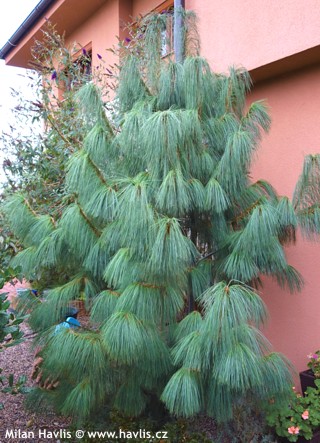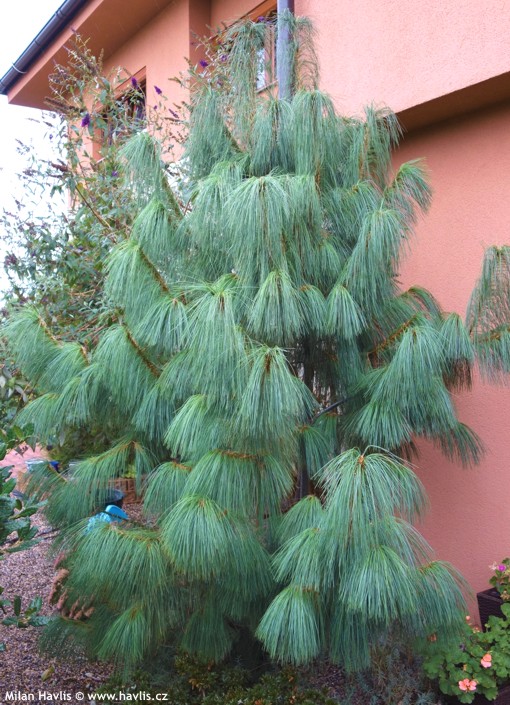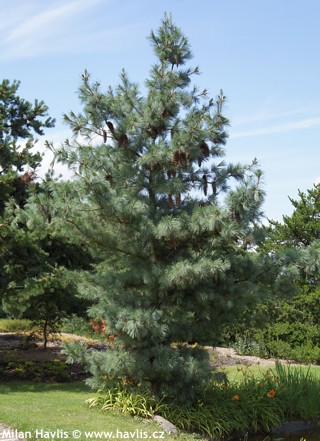Pinus wallichiana (syn. P. griffithii, P. excelsa) Himalayan pine


It comes from the Himalayas with the altitude of up to approx. 4000 m, from Afghanistan through Nepal and Pakistan to the Yunnan province in the south-west of China. Its seeds were first collected and brought to Europe by Danish botanist Nathaniel Wallich (1786-1854) and in 1827 he showed them to his colleagues in England along with drawings of the species he discovered. Upon his return home he sowed them and within nine years he had the first plants to sell through a European nursery. Nowadays it is available in all parts of the temperate zone, but for some reason it is still quite rare in cultivation.
It bears very decorative, gracefully drooping, silver-blue needles that are soft to touch, 12-18 cm long, grow in whorls of 5 and last 3-4 years before falling off while the tree makes new ones at the ends of the branches. Another highlight are the slender, long cones which appear already on relatively young plants. In the first year they are small and upright, and in the second year they grow to 15-25 cm and droop. They are highly resinous so be careful.
The tree’s habit is broadly pyramidal and in open space it is reliably branched to the ground. However, if it has to compete for space and light due to other trees growing in close vicinity it loses its lower framework and rushes up towards the sun. The branches are mostly horizontal, only the tips are slightly ascending. The trunk is straight and strong, the bark is grey-brown, fissured and peels off in large scales with age. Himalayan pine grows fast, half a meter or more per year under ideal conditions, and in Europe it gets about 25 m tall and about half as wide when fully mature. Nevertheless, more than a hundred-year-old specimens are known that have doubled these figures.
Same as any other pine, it loves full sun and copes with almost any soil type that is not waterlogged. It does not require feeding, is resistant to diseases and tolerates urban pollution. In terms of location, it prefers valleys and areas with a more enclosed microclimate with higher humidity. Especially young seedlings do not like harsh winters and exposed sites open to strong winds. Hardy to at least -29 °C, and after the trunk tissues have matured, it can handle short-term spells a few degrees lower. (USDA zone 5).
Last update 18-03-2007; 01-02-2024
Goods are shipped all over Europe. For Russia and U.K. and for further details please read about SHIPPING OPTIONS HERE.
Are you interested in a serious discount for orders NOV-FEB? Check your options here.
THE PRICES INCLUDE VAT of 15%. For quick conversion you can use 1 CZK = approx. 0.04 EUR
- STANDARD QUALITY - Plants of this group are 1st class quality with number of branches and overall density adequate to their size and age, considering they were container grown.
- DE LUXE QUALITY - This label guarantees a luxurious quality of manually selected plants that, compared to their height and age, are exceptionally dense and beautiful.
- EXTRA - These plants are usually mature and bigger specimens with exceptional overall appearance.
- STANDARD (as described in the plant form) means a tree with a trunk of 190-210 cm and a crown at the top, unless specified differently. The commercial size for trees is their girth measured in the height of 1m from ground.
- HOBBY - These plants are of the same quality as our standard-quality plants but younger and therefore cheaper.
- SHRUB - a woody plant with branches growing bushy from the ground level.
- HALF-STANDARD or MINI-STANDARD - a small tree with shorter trunk, its size is usually specified.
- FEATHERED - These are trees with branches growing already from the base of the trunk and up along the stem.
- GRASSES and PERENNIALS - Sizes given usually read the diameter of the pot or the clump, as specified.















